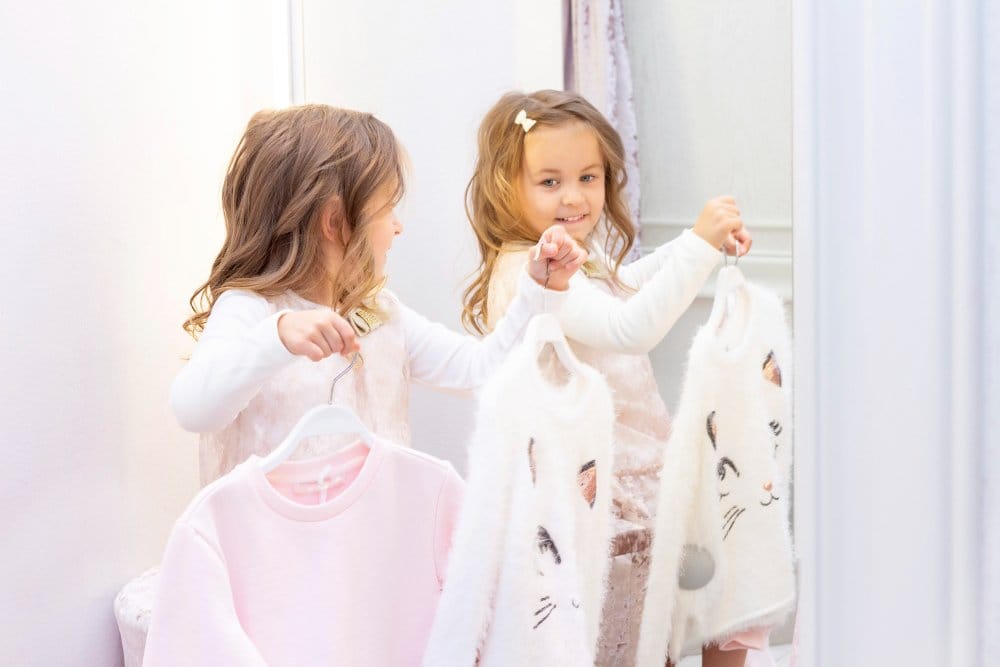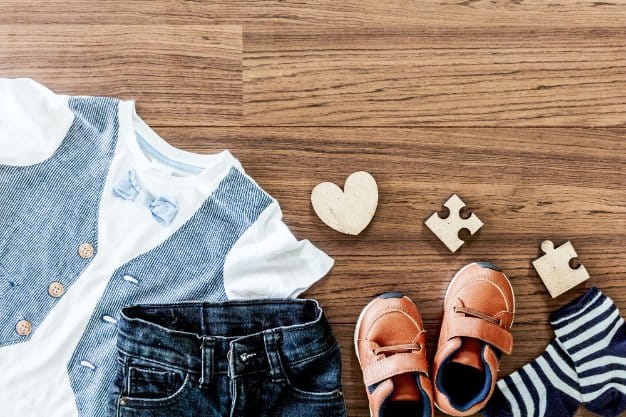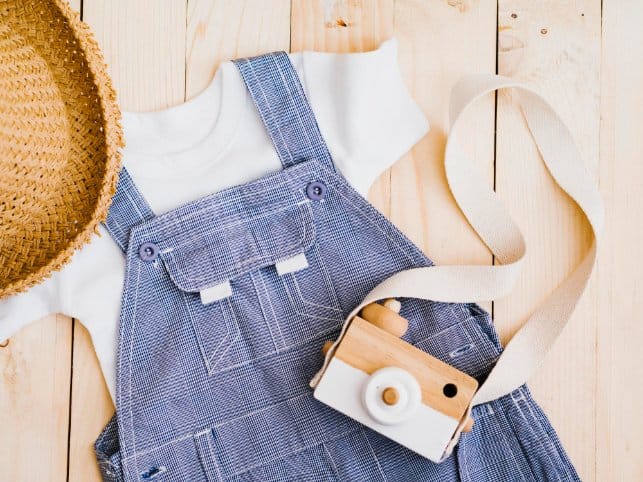Essential wardrobe planning guide with budget tips, safety standards, and seasonal recommendations for busy parents
Table of Contents
- Why Determining the Right Amount Matters
- Essential Clothing Items for Toddlers
- Complete Toddler Sizing Guide
- Safety Standards and Compliance
- Seasonal Considerations
- Budget Planning and Cost Breakdown
- Building a Capsule Wardrobe
- Special Clothing Needs and Occasions
- Care and Maintenance
- Frequently Asked Questions
Quick Answer: Most families find that 7-10 tops, 5-8 pairs of pants, 3-5 pajama sets, and 10-12 pairs of socks and underwear cover almost all daily needs for toddlers. The exact number depends on your laundry routine, climate, and child’s activities.
When you start building your toddler’s wardrobe, you might wonder how much clothing is really enough without being too much. Toddlers grow fast, get messy, and need clothes for all sorts of activities. Finding the right balance helps you stay organized while keeping your child comfortable and properly dressed.
Why Determining the Right Amount of Toddler Clothes Matters
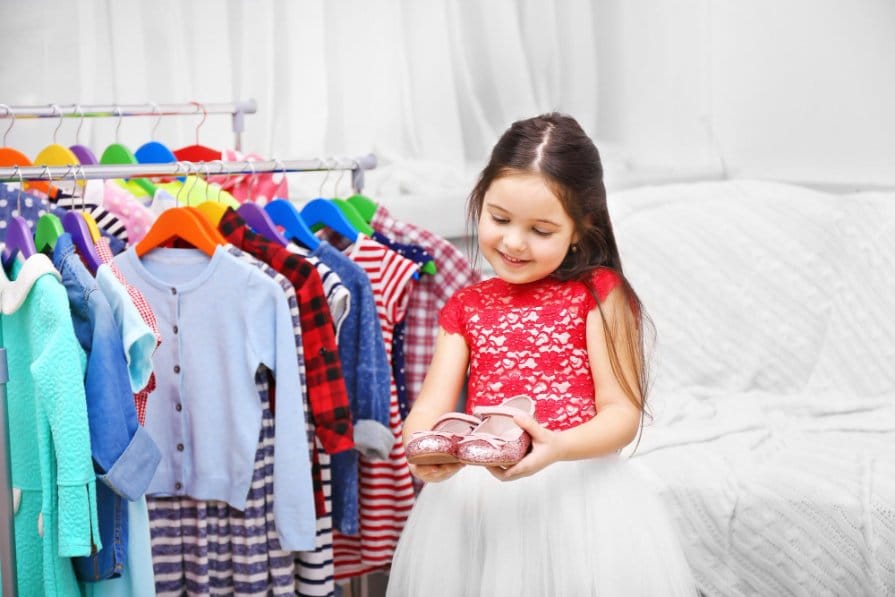
A well-organized toddler wardrobe helps balance comfort, convenience, and cost
The number of toddler outfits you keep is a key part of planning your child’s wardrobe. Making smart choices helps you balance comfort, convenience, and cost as your toddler grows.
Comfort and Practicality
Comfort should be your top priority when choosing clothing. Toddlers move a lot, so pick clothes that are soft, stretchy, and easy for your child to wear all day. Simple outfits without too many snaps, buttons, or zippers make dressing quick and stress-free.
Outfits with elastic waists, wide necklines, and easy fasteners let your toddler dress or undress more easily. Skip clothes that are tight or fussy because your child needs clothes for napping, playing, and moving around. Using natural and synthetic fabrics that offer the right balance of comfort and durability is essential.
Laundry Frequency and Lifestyle
How often you do laundry determines how many toddler outfits you should keep. If you wash clothes every day, five to seven sets are usually enough. If laundry happens less often, you need more outfits to get through the week without running out.
Your schedule and your toddler’s activities also shape your choices. Add extra clothes for daycare, trips to the park, or messy meals. Spills, dirt, and potty training accidents can mean two or more outfit changes in one day.
| Laundry Days per Week | Suggested Outfits Needed | Notes |
|---|---|---|
| Daily (7) | 5-7 outfits | Minimal wardrobe possible |
| Every other day (3-4) | 8-10 outfits | Most common setup |
| Weekly (1-2) | 10-14 outfits | Requires larger wardrobe |
Growth Spurts and Changing Needs
Toddlers grow fast, so last year’s clothing may not fit for long. Small wardrobes make it easier to keep up with new sizes or changing seasons. Choose versatile toddler outfits that work for both warm and cool days, like short-sleeve shirts with cardigans or leggings.
When you notice your child is close to outgrowing certain clothes, start with a few new pieces instead of replacing everything at once. This limits waste and saves money. Learning about how kids clothes sizes work can help you plan better for growth spurts. Use our toddler size transition tracker to predict when your child will need the next size up.
Essential Clothing Items for Toddlers
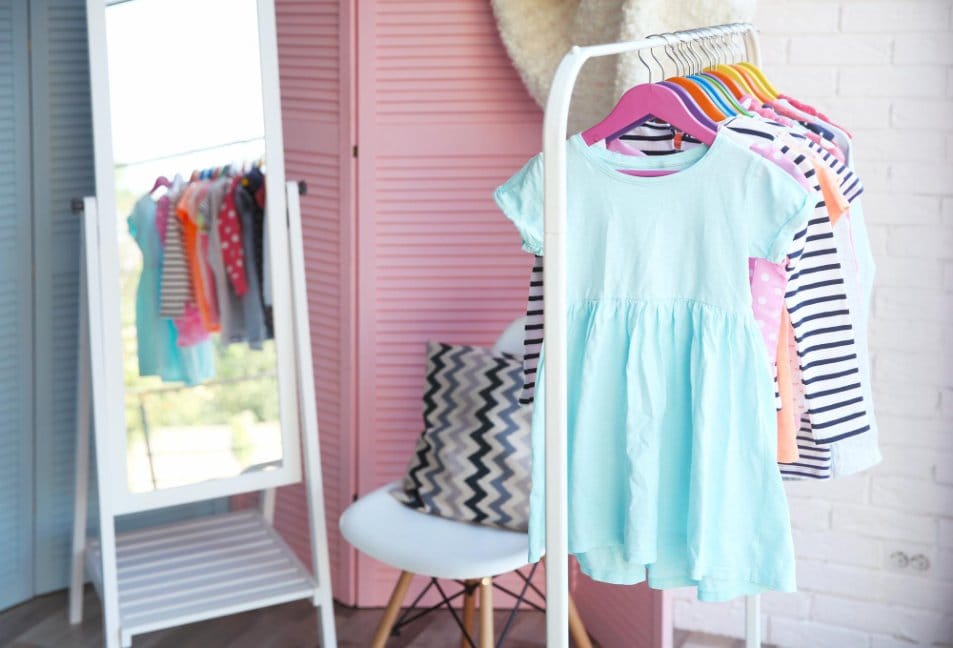
Essential toddler clothing items for comfort, flexibility, and practicality
Focus on comfort, flexibility, and practicality when choosing clothing for your toddler. The right amount of each item depends on daily routines, laundry schedules, and the season.
Everyday Wear: Tops, Bottoms, and Dresses
For everyday wear, 5-7 t-shirts or tops work best, since toddlers are likely to get messy. Keep 5-7 pairs of pants, shorts, or leggings ready because spills and outdoor play can require frequent changes.
If your toddler wears dresses, include 2-4 casual dresses for variety. Keep some pairs of tights or leggings to go under dresses, as these add warmth and comfort.
Essential Everyday Items Checklist:
- 5-7 comfortable t-shirts or tops
- 5-7 pairs of pants, shorts, or leggings
- 2-4 casual dresses (if preferred)
- 3-4 pairs of leggings for layering
- 2-3 cardigans or light jackets
Undergarments and Basics
Always make sure your child has enough undergarments for the week. This usually means 7-10 pairs of underwear if your toddler is potty trained. For younger toddlers, have plenty of onesies or bodysuits on hand, at least 5-7.
Socks can disappear easily, so keep 8-10 pairs of socks available. For toddlers who wear dresses, add 2-4 pairs of tights. Understanding cotton vs polyester fabric differences helps you choose the most comfortable undergarments.
Sleepwear and Pajamas
Sleepwear should be both comfortable and safe. Keep at least 3-5 sets of pajamas. This gives you extras for accidents or nighttime leaks.
Safety Note: Choose sleepwear with snug fits for safety, especially if your child is still in a crib. According to the American Academy of Pediatrics, loose-fitting sleepwear can pose safety risks. Children’s flame-retardant clothing requirements ensure additional safety.
How Many Pairs of Pajamas Should a Toddler Have?
The ideal number depends on your laundry schedule:
- Daily laundry: 3-4 pairs sufficient
- Twice weekly laundry: 4-5 pairs recommended
- Weekly laundry: 6-7 pairs needed
What Do 2 Year Olds Sleep In?
Two-year-olds typically sleep in:
- Two-piece cotton pajamas (pants and top)
- One-piece sleepers for cooler nights
- Sleep sacks for transitioning from crib
- Lightweight cotton for warm weather
When to Switch Toddler to 2 Piece Pajamas?
Most children transition to two-piece pajamas around 18-24 months when they become more mobile and start potty training. Two-piece sets make bathroom trips easier and give toddlers more independence.
Seasonal Outerwear and Layering
Change your approach as the seasons change. In cold months, make sure to have a warm coat, hat, mittens, and boots. Keep a few sweaters or hoodies for layering.
In warmer months, choose a lightweight jacket or raincoat for chilly mornings or rainy days. Keep at least one sun hat or cap for outside play. For swimming, have one or two swimsuits handy. Our seasonal wardrobe checklist can help you plan exactly what you need for each season.
Complete Toddler Sizing Guide
Understanding toddler sizing helps you buy the right fit and plan for growth. Sizing systems can be confusing, but knowing the basics saves time and money.
Understanding Toddler Size Systems
Toddler sizes typically use the “T” system (2T, 3T, 4T, 5T) which stands for “toddler.” These sizes are designed differently from regular children’s sizes to accommodate diapers and allow for more movement.
Standard Toddler Size Chart
| Size | Age Range | Weight (lbs) | Height (inches) | Chest (inches) |
|---|---|---|---|---|
| 2T | 18-24 months | 24-28 | 32-34 | 20-21 |
| 3T | 2-3 years | 28-32 | 34-37 | 21-22 |
| 4T | 3-4 years | 32-36 | 37-40 | 22-23 |
| 5T | 4-5 years | 36-42 | 40-43 | 23-24 |
International Size Conversions
When shopping internationally or for imported clothes, these conversions help:
| US Size | UK Size | EU Size | Height (cm) |
|---|---|---|---|
| 2T | 18-24M | 86-92 | 81-86 |
| 3T | 2-3Y | 92-98 | 86-94 |
| 4T | 3-4Y | 98-104 | 94-102 |
| 5T | 4-5Y | 104-110 | 102-109 |
Should You Buy Toddler Clothes a Size Up?
The answer depends on several factors:
When to Size Up:
- Your child is between sizes
- It’s the end of a growth season
- You’re buying winter coats (for layering)
- The brand runs small
When to Buy True to Size:
- For everyday basics worn frequently
- Safety items like sleepwear (should fit snugly)
- Shoes (too big can cause trips and falls)
- Underwear and socks
Brand-Specific Sizing Variations
Different brands fit differently. Here’s what to know:
- Carter’s: Generally runs true to size, good for stockier builds
- Gap: Tends to run large, especially in length
- H&M: European sizing, often runs smaller
- Target (Cat & Jack): True to size, good value
- Old Navy: Can run large, check reviews
Safety Standards and Compliance
Understanding safety standards protects your child and ensures you’re buying compliant clothing. These regulations exist for good reasons and knowing them helps you make safer choices.
Key Safety Regulations
Important: All children’s clothing sold in the US must comply with Consumer Product Safety Improvement Act (CPSIA) requirements, including lead content limits and flammability standards.
Drawstring Safety Requirements
Drawstrings pose serious safety risks. Current regulations require:
- No drawstrings in hood or neck areas for sizes 2T-12
- Waist drawstrings must be anchored to prevent full removal
- No toggles or knots on functional drawstrings
- Length limits on all drawstrings to prevent entanglement
Flammability Standards
Children’s sleepwear must meet strict flammability requirements:
- Snug-fitting sleepwear for sizes 9 months through 14
- Flame-resistant treatment for loose-fitting sleepwear
- Specific fabric weight and construction requirements
- No loose-fitting cotton sleepwear unless treated
Small Parts and Choking Hazards
For children under 3 years:
- Buttons must be securely attached and tested for pull strength
- No small decorative elements that can detach
- Snaps and fasteners must meet durability standards
- Regular inspection of clothing for loose parts
Chemical Safety Requirements
Children’s clothing must meet limits for:
- Lead content: Maximum 100 ppm in accessible parts
- Phthalates: Restricted in items intended for mouthing
- Formaldehyde: Limited levels in finished garments
- Heavy metals: Restrictions on cadmium and other toxic metals
Safety Tip: Look for OEKO-TEX Standard 100 certification, which tests for over 100 harmful substances and ensures textiles are safe for human health.
Seasonal Considerations

Planning seasonal clothing helps keep toddlers comfortable year-round
Clothing needs change as the weather shifts. Planning for each season helps keep your toddler comfortable while managing your budget effectively. Use our seasonal shopping timeline to know when to buy different items for the best deals.
Warm Weather Clothing
In warm months, choose light fabrics like cotton and loose-fitting clothes that help keep your toddler cool. Usually have around 7-10 t-shirts or tank tops and 5-7 shorts or skirts in rotation.
Summer Essentials:
- 7-10 lightweight t-shirts or tank tops
- 5-7 pairs of shorts or skirts
- 2-3 swimsuits
- 2-3 sun hats
- Light sandals and closed-toe shoes
- 1-2 light cardigans for air conditioning
Cold Weather Essentials
When it gets cold, switch to long-sleeve tops, sweaters, and warm pants. Have about 7-10 long-sleeve shirts and 7-10 pairs of pants. Two or three thick sweaters or hoodies work well for layering.
Winter Must-Haves:
- 7-10 long-sleeve shirts
- 7-10 pairs of warm pants
- 2-3 thick sweaters or hoodies
- 1 insulated winter coat
- 2-3 warm hats
- 2-3 pairs of mittens or gloves
- Waterproof boots
- 10+ pairs of warm socks
Rainy Day Gear
Rainy days require special gear to keep your toddler dry. A well-fitting raincoat with a hood is essential. Keep two so there’s always a dry one available.
What to Pack for a Holiday with a 2 Year Old?
Holiday packing requires strategic planning:
- 1.5x daily outfits: Pack more than days planned
- Weather backup: Layers for temperature changes
- Comfort items: Favorite pajamas and comfort clothes
- Easy-wash items: Choose machine-washable fabrics
- Mix and match: Coordinating pieces that work together
Budget Planning and Cost Breakdown
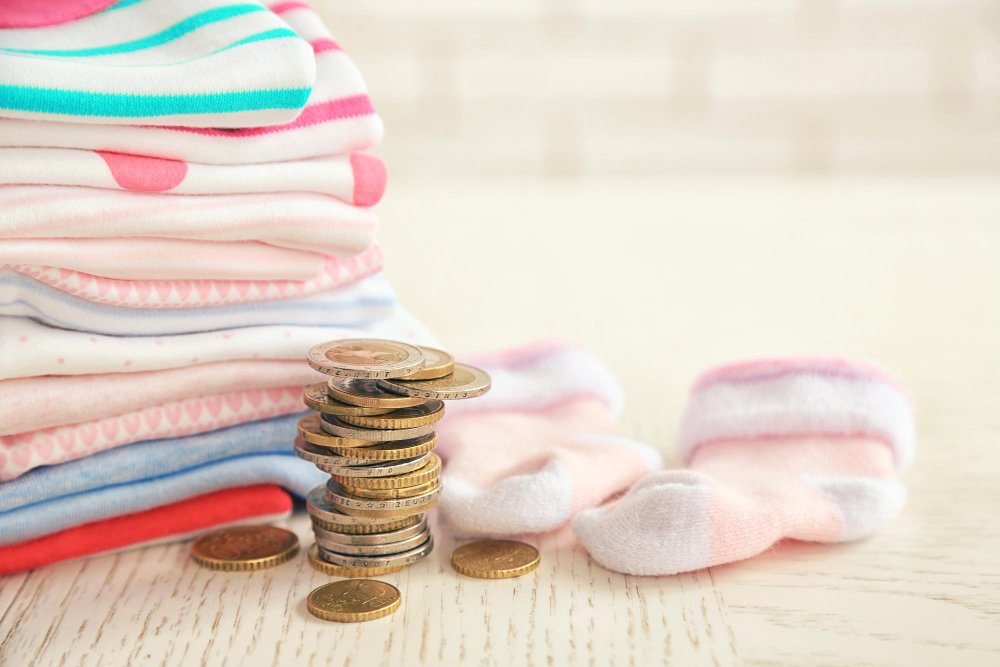
Smart budget planning helps manage toddler clothing costs effectively
Understanding clothing costs helps you plan financially and make smart purchasing decisions. The average family spends $300-350 per child annually on clothing, but this varies significantly based on choices and circumstances. Our budget calculator can help you determine the right amount to spend based on your family’s specific needs.
Annual Clothing Budget Breakdown
| Category | Budget Range | Percentage of Total | Money-Saving Tips |
|---|---|---|---|
| Everyday clothes | $120-180 | 40-50% | Buy multipacks, shop sales |
| Shoes | $80-120 | 25-30% | Buy versatile styles, check outlets |
| Outerwear | $60-100 | 15-25% | End-of-season sales, quality pieces |
| Special occasion | $40-60 | 10-15% | Rent for one-time events |
Monthly Clothing Costs by Age
Toddler clothing costs vary by age and development stage:
| Age Range | Monthly Cost | Main Cost Drivers | Cost-Saving Strategies |
|---|---|---|---|
| 12-18 months | $60-100 | Rapid growth, frequent changes | Hand-me-downs, basic styles |
| 18-24 months | $50-80 | Potty training, active play | Easy-wash fabrics, extra pants |
| 2-3 years | $40-70 | Preference development, shoes | Involve child in selection, durability focus |
| 3-4 years | $35-60 | School needs, seasonal items | Uniforms, capsule wardrobes |
Smart Shopping Strategies
Best Times to Buy:
- End of season: 50-70% off winter and summer items
- Back-to-school: July-August for basics
- Holiday sales: Black Friday and post-Christmas
- Clearance cycles: Every 6-8 weeks for new inventory
For a complete timeline of when to shop for different items, check our seasonal shopping timeline guide.
Budget-Friendly Shopping Tips
- Set a seasonal budget and stick to it
- Shop your child’s closet first before buying new
- Invest in quality basics, save on trendy pieces
- Consider quality baby clothes from reliable retailers
- Join store loyalty programs for exclusive discounts
- Buy slightly larger sizes during major sales
Building a Capsule Wardrobe
A capsule wardrobe uses fewer, versatile pieces that work together. This approach saves money, reduces clutter, and makes getting dressed easier for both you and your toddler.
Step-by-Step Capsule Creation
Choosing Your Color Palette
Start with 2-3 main colors plus neutrals. This ensures everything mixes and matches:
| Color Scheme | Main Colors | Neutrals | Best For |
|---|---|---|---|
| Classic | Navy, red | White, gray | Timeless, versatile |
| Earth Tones | Forest green, rust | Cream, brown | Natural, calming |
| Bright & Fun | Turquoise, yellow | White, black | Energetic toddlers |
| Pastels | Soft pink, mint | Ivory, light gray | Gentle, sweet look |
Core Capsule Pieces
Essential Capsule Items (Ages 2-4):
- 6 tops (mix of short and long sleeve)
- 5 bottoms (pants, shorts, skirts)
- 2 dresses (girls)
- 3 layering pieces (cardigans, hoodies)
- 1 jacket or coat
- 7-10 underwear/undershirts
- 3-4 pajama sets
- 8-10 pairs of socks
Seasonal Capsule Adjustments
Adapt your capsule for different seasons without starting over:
Spring Transition:
- Add light layers and rain gear
- Swap heavy coats for lighter jackets
- Include versatile pieces for temperature swings
Summer Minimalism:
- Focus on lightweight, breathable fabrics
- Add sun protection accessories
- Include swimwear and summer shoes
Fall Preparation:
- Layer-friendly pieces become essential
- Add warm accessories and closed-toe shoes
- Prepare for back-to-school needs
Our seasonal wardrobe checklist helps ensure you have everything needed for smooth transitions between seasons.
Winter Essentials:
- Heavy outerwear and warm layers
- Weather-appropriate footwear
- Extra warm accessories
Special Clothing Needs and Occasions
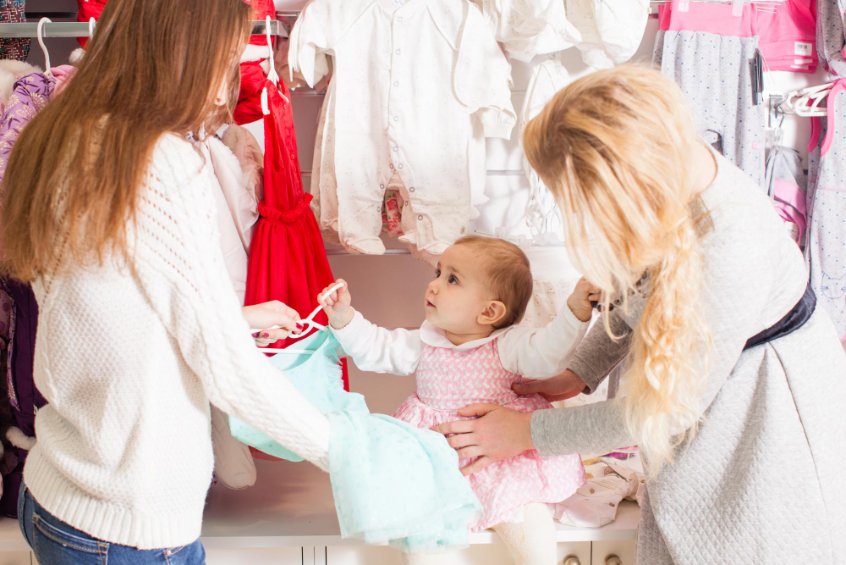
Special occasions and activities require specific clothing considerations for toddlers
Beyond everyday clothes, toddlers need specific items for special events, activities, and unique circumstances.
Daycare and Nursery Requirements
How Many Spare Clothes for Daycare?
Most daycares require a complete change of clothes kept on-site:
- Minimum: 1 complete outfit in current size
- Recommended: 2 complete outfits plus extra underwear/socks
- Seasonal updates: Replace quarterly or as child grows
- Easy-on clothes: Velcro shoes, elastic waists for staff convenience
Can Toddlers Wear Onesies to Daycare?
Onesies are generally acceptable for younger toddlers (12-24 months) but consider:
- Potty training progress (snaps make bathroom trips harder)
- Daycare’s specific policies
- Child’s ability to dress independently
- Comfort during nap time
What to Pack in a Toddler Daycare Bag?
Daily Daycare Essentials:
- 1-2 complete outfit changes
- Extra underwear and socks
- Labeled personal items
- Weather-appropriate outerwear
- Comfort item if allowed
- Any special dietary or medical needs clothing
Learn more about how to label toddler clothes for daycare to prevent lost items.
Travel and Packing Considerations
How Many Clothes to Pack for a Toddler?
Packing depends on trip length and activities:
| Trip Length | Daily Outfits | Extra Items | Special Considerations |
|---|---|---|---|
| Weekend (2-3 days) | 1.5x days | 2 spare outfits | Easy-wash items |
| Week-long | 1.25x days | 3-4 spare outfits | Laundry access helpful |
| Extended (2+ weeks) | 1x days + basics | Plan to do laundry | Mix-and-match pieces |
For more detailed guidance, check our article on how to pack toddler clothes for travel.
Independence and Self-Dressing
Should a 2.5 Year Old Dress Themselves?
By 2.5 years, toddlers can typically:
- Put on and take off simple shirts
- Pull up pants with elastic waists
- Put on socks (though not perfectly)
- Choose between two outfit options
- Put arms through sleeves with help
Encouraging Independence: Choose clothes with larger necklines, elastic waists, and velcro fasteners. Avoid buttons, tight fits, and complex closures that frustrate developing motor skills.
Many parents find it helpful to let their toddler pick their own clothes within reasonable choices.
Special Considerations and Adaptive Clothing
Sensory-Friendly Options
Some toddlers have sensory sensitivities requiring special attention:
- Tagless or soft-tag clothing
- Seamless or flat-seam construction
- Soft, natural fabrics like cotton
- Loose-fitting styles for comfort
- Avoid scratchy materials or rough textures
Adaptive Clothing Features
For children with special needs:
- Magnetic closures instead of buttons
- Side-opening pants for easier changing
- Seated-wear designs
- Extra room for medical equipment
- Easy-access features for caregivers
Care and Maintenance
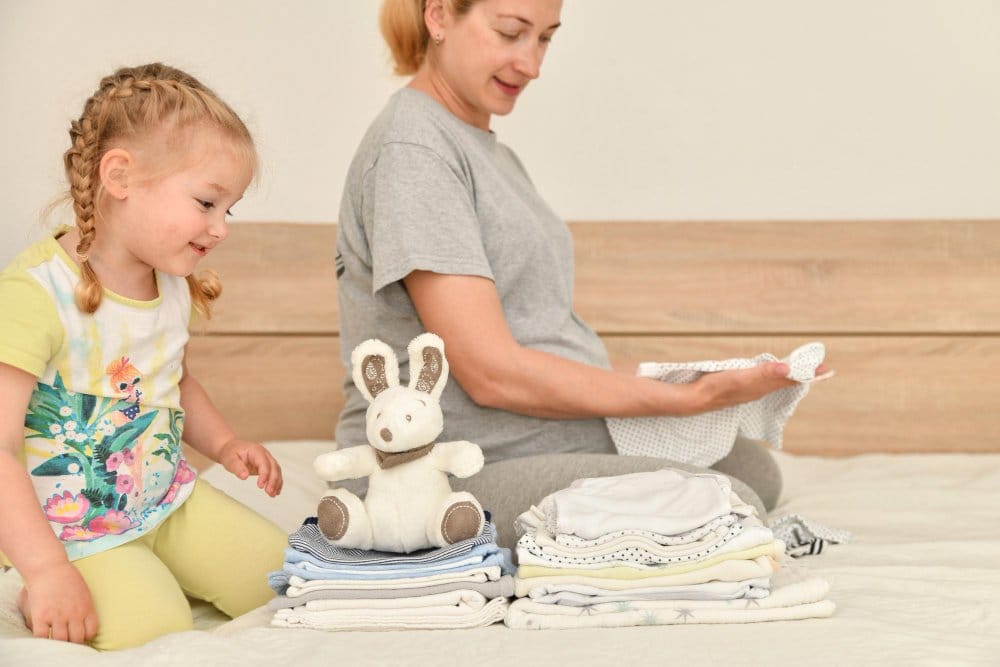
Proper care and maintenance extends clothing life and maintains safety standards
Proper care extends clothing life and maintains safety standards. Knowing when and how to maintain toddler clothes saves money and keeps your child comfortable.
Washing and Care Guidelines
How Often Should You Change Toddler PJs?
Pajama frequency depends on several factors:
- Daily changes: If child sweats heavily or has accidents
- Every 2-3 nights: For typical wear with good hygiene
- Immediately: After illness, accidents, or spills
- Fresh for naps: If used for both night and day sleep
How Many Times Should You Wear the Same Pajamas?
General guidelines for pajama reuse:
- 2-3 wears: If child stays clean and dry
- 1 wear: During illness or potty training
- Seasonal consideration: More frequent changes in summer heat
- Fabric matters: Natural fibers may need more frequent washing
Fabric-Specific Care Instructions
Different fabrics require different care approaches. Understanding how to wash and care for different fabrics prevents damage and maintains clothing quality.
| Fabric Type | Washing Temperature | Drying Method | Special Care |
|---|---|---|---|
| Cotton | Warm (30-40°C) | Tumble dry medium | Pre-treat stains |
| Polyester blends | Cool (20-30°C) | Low heat or air dry | Remove promptly to prevent wrinkles |
| Wool | Cool, gentle cycle | Lay flat to dry | Use wool-specific detergent |
| Delicates | Cold, hand wash preferred | Air dry only | Turn inside out |
Stain Removal for Common Toddler Messes
Emergency Stain Treatment:
- Food stains: Rinse immediately with cold water
- Grass stains: Pre-treat with liquid detergent
- Blood: Soak in cold water, never hot
- Mud: Let dry completely, then brush off before washing
- Paint: Act fast – rinse while wet
Organization and Storage
Efficient organization makes daily dressing easier and helps track what you have. Learn effective techniques for folding and organizing toddler clothes in drawers.
Seasonal Storage Tips
- Use clear bins labeled by size and season
- Store clean, completely dry clothes only
- Include moth protection for wool items
- Check stored items quarterly for damage
- Keep an inventory list for each bin
When to Replace vs. Repair
Signs It’s Time to Size Up
Watch for these indicators that clothes are too small:
- Shirts hard to pull over head
- Sleeves don’t cover wrists
- Pants tight at waist or show ankles
- Child complains of discomfort
- Marks on skin from tight clothing
- Snaps popping open frequently
Repair vs. Replace Decision Guide
| Issue | Repair If | Replace If |
|---|---|---|
| Small hole | In non-stress area, favorite item | In seam or high-wear area |
| Loose button | Button available, good fit | Multiple buttons missing |
| Stain | Partial stain, everyday wear | Large, permanent stain |
| Fading | Even fading, still fits | Uneven or severe fading |
Clothing Lifecycle Management
Managing clothing through its complete lifecycle maximizes value:
Consider these options for clothes your child has outgrown:
- Hand-me-downs: Pass to younger siblings or friends
- Donation: Local charities, daycares, or shelters
- Selling: Online platforms for quality items
- Upcycling: Transform into play clothes or crafts
- Textile recycling: Many retailers accept worn textiles
For more ideas, see our guide on what to do with old toddler clothes.
Frequently Asked Questions
Conclusion
Building the right wardrobe for your toddler doesn’t have to be overwhelming. By focusing on practical quantities, quality basics, and understanding your family’s specific needs, you can create a functional wardrobe that grows with your child while staying within budget.
Key Takeaways
- Essential quantities: 7-10 tops, 5-8 bottoms, 3-5 pajama sets, and 10-12 pairs of socks and underwear meet most families’ needs
- Prioritize safety: Choose snug-fitting sleepwear, avoid drawstrings in dangerous areas, and ensure all clothing meets current safety standards
- Budget wisely: Expect to spend $300-350 annually per child, with monthly costs of $40-100 depending on age and needs
- Size strategically: Understand sizing systems, buy quality pieces in current size, and consider sizing up for seasonal outerwear
- Plan seasonally: Adjust quantities based on climate and activities, keeping layering options available year-round
Final Recommendations
Start with the basics and build gradually. Your child’s wardrobe should reflect your family’s lifestyle, budget, and values. Whether you choose a minimalist capsule approach or prefer having more options available, the key is finding what works sustainably for your family.
Remember that children grow quickly, and their needs change with development. Regular wardrobe assessments help you stay ahead of growth spurts while avoiding waste. Focus on comfort, safety, and practicality over trends, and don’t be afraid to adjust your approach as you learn what works best for your child.
Most importantly, involve your toddler in age-appropriate clothing decisions. This builds independence, ensures they’re comfortable in their clothes, and can make daily dressing routines more pleasant for everyone involved.
Next Steps: Start by taking inventory of your current wardrobe, identify gaps based on the guidelines in this article, and create a seasonal shopping plan that fits your budget. Use our seasonal wardrobe checklist and budget calculator to make the process easier. Remember, building a great toddler wardrobe is a process, not a one-time task.

